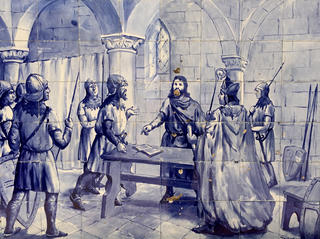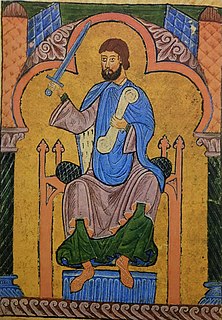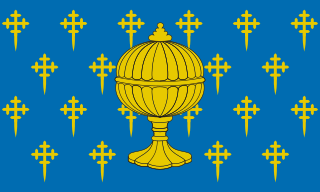
Afonso I, also called Afonso Henriques, nicknamed the Conqueror by the Portuguese, and El-Bortukali and Ibn-Arrink or Ibn Arrinq by the Moors whom he fought, was the first king of Portugal. He achieved the independence of the County of Portugal, establishing a new kingdom and doubling its area with the Reconquista, an objective that he pursued until his death.

Ferdinand II, was a member of the Castilian cadet branch of the House of Ivrea and King of León and Galicia from 1157 until his death.

Alfonso VII, called the Emperor, became the King of Galicia in 1111 and King of León and Castile in 1126. Alfonso, born Alfonso Raimúndez, first used the title Emperor of All Spain, alongside his mother Urraca, once she vested him with the direct rule of Toledo in 1116. Alfonso later held another investiture in 1135 in a grand ceremony reasserting his claims to the imperial title. He was the son of Urraca of León and Raymond of Burgundy, the first of the House of Ivrea to rule in the Iberian peninsula.

The Battle of Ourique was a battle that took place on 25 July 1139, in which the forces of Portuguese count Afonso Henriques defeated those led by the Almoravid governor of Córdoba, Muhammad Az-Zubayr Ibn Umar, identified as "King Ismar" in Christian chronicles.

The Battle of São Mamede took place on 24 June 1128 near Guimarães and is considered the seminal event for the foundation of the Kingdom of Portugal and the battle that ensured Portugal's Independence. Portuguese forces led by Afonso Henriques defeated forces led by his mother Teresa of Portugal and her lover Fernão Peres de Trava. Following São Mamede, the future king styled himself "Prince of Portugal". He would be called "King of Portugal" starting in 1139 and was recognised as such by neighbouring kingdoms in 1143.
This is a historical timeline of Portugal.

The Treaty of Zamora recognized Portuguese independence from the Kingdom of León. Based on the terms of the accord, King Alfonso VII of León recognized the Kingdom of Portugal in the presence of his cousin King Afonso I of Portugal, witnessed by the papal representative, Cardinal Guido de Vico, at the Cathedral of Zamora. Both kings promised durable peace between their kingdoms. By this treaty Afonso I of Portugal also recognized the suzerainty of the Pope.

Raymond of Burgundy was the ruler of Galicia from about 1090 until his death. He was the fourth son of Count William I of Burgundy and Stephanie. He married Urraca, future queen of León, and was the father of the future Alfonso VII.

The Kingdom of Galicia was a political entity located in southwestern Europe, which at its territorial zenith occupied the entire northwest of the Iberian Peninsula. It was founded by the Suebic king Hermeric in 409, with its capital established in Braga. It was the first kingdom which adopted Catholicism officially. In 449 it minted its own currency. In 585, it became a part of the Visigothic Kingdom. In the 8th century, Galicia became a part of the newly founded Christian Kingdom of Asturias, which later became the Kingdom of León, while occasionally achieving independence under the authority of its own kings. Compostela became capital of Galicia in the 11th century, while the independence of Portugal (1128) determined its southern boundary. The accession of Castilian King Ferdinand III to the Leonese kingdom in 1230 brought Galicia under the control of the Crown of Castile.

The Cathedral of Braga is a Roman Catholic church in the northern city of Braga, Portugal. Due to its long history and artistic significance, it is also one of the most important buildings in the country. It is the seat of the Archdiocese of Braga and of the Primate Archbishop of Portugal and Spain.
Uberto Lanfranchi was the Cardinal-deacon of Santa Maria in Via Lata, then the Cardinal-priest of San Clemente, and finally the Archbishop of Pisa.
FernandoPérez de Traba, also Fernão Peres de Trava in Portuguese, was a nobleman and count of the Kingdom of León who for a time held power over all Galicia. He became the lover of Countess Teresa of Portugal, through whom he attained great influence in that domain, and was the de facto ruler of the County of Portugal between 1121 and 1128. The Poema de Almería, a Latin poem celebrating one of Alfonso VII's major victories of the Reconquista, records that "if one were to see him [Fernán], one would judge him already a king."
Sancho Alfónsez was the only son of King Alfonso VI of Castile and León; his mother was the Moorish princess Zaida. Alfonso's heir from May 1107, he eventually co-ruled from Toledo. He predeceased his father, being killed while trying to escape the field of the Battle of Uclés. His death, on his first recorded military expedition, precipitated a succession crisis that ended with the accession of his elder half-sister Urraca and her husband, Alfonso the Battler, already King of Navarre and Aragon, to the throne of Kingdom of Castile-León.
Munio or Muño Peláez was a Galician magnate, a member of the Banu Gómez clan, during the reigns of Alfonso VI, Urraca and Alfonso VII. By December 1108 he held the title of comes (count), the highest in the kingdom. He was a son of count Pelayo Gómez, grandson son of Gómez Díaz de Carrión and Teresa Peláez. His mother was Elvira Muñoz, half-sister of count Rodrigo Muñoz, and daughter of Munio Rodríguez and Ilduara Velázquez. Elvira's ancestors had founded the monastery of Santa María de Ferreira.

Rodrigo Vélaz was the "count of Galicia, who held Sarria" according to the near-contemporary Chronica Adefonsi imperatoris. During his long public career he was the dominant figure in mountainous eastern Galicia while the House of Traba dominated its western seaboard. He served under three monarchs—Alfonso VI, Urraca, and Alfonso VII—and was loyal to all of them, never figuring in any rebellion. The contemporary Historia compostellana is a valuable source for his life, since there are no aristocratic archives surviving in Spain from this period. Rodrigo's career must be pieced together from the few references in the chronicles and the charters preserved in various ecclesiastical archives.

Rodrigo Pérez de Traba, called el Velloso, was a Galician magnate whose career corresponds to the entire period from the coronation of Alfonso VII as co-ruler of León (1111) until his death (1157). He served Alfonso at court in his early years, but was given increased responsibility in Galicia after the death of Alfonso's mother, Queen Urraca (1126). After about 1132 he became increasingly involved in the politics of Portugal, whose invasion of Galicia he supported in 1137. Even after León and Portugal made peace in 1141 Rodrigo was largely excluded from Leonese politics, with the notable exception of the military campaigns of 1147, until 1152. Thereafter until his death he was the dominant lay figure in Galicia.
Fernando Yáñez was a minor Galician nobleman—a miles, or mere knight—who rose in rank in the service of Queen Urraca (1109–26) and King Alfonso VII (1126–57). He eventually became the royal military commander charged with the defence of the Limia on the border between Galicia and Portugal. Contemporary sources call him the "prince" and "duke" of Limia.
Fernando Pérez de Lara, also called Fernando Furtado or Hurtado, was the illegitimate son of Urraca, queen regnant of León and Castile, and her lover, Count Pedro González de Lara.
The Treaty of Tuy was a treaty signed in Tuy, the Kingdom of León, in 1137 between the Count of Portugal, Afonso Henriques, and the King of León, Alfonso VII the Emperor. It put an end to the Portuguese-Leonese War of 1130-1137.











